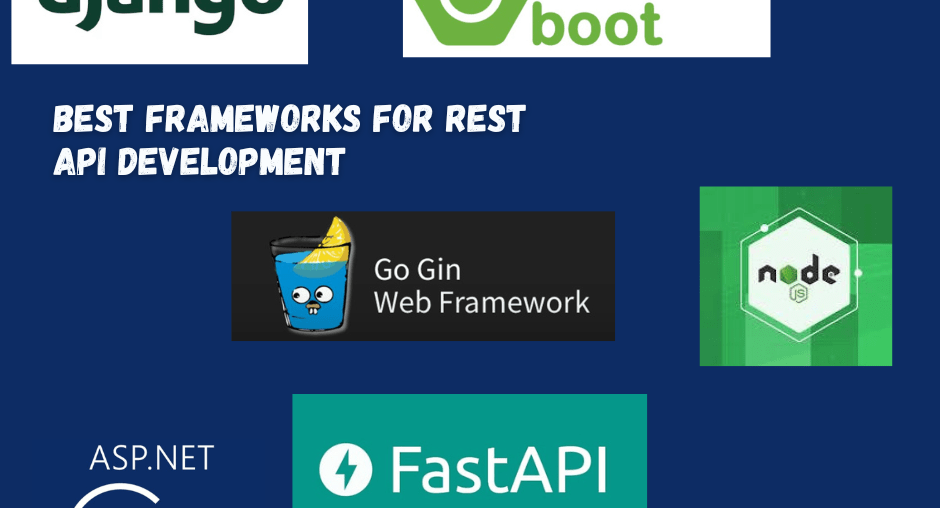RESTful APIs (representational state transfer) are an essential component of current application development. They enable system communication, making it possible for web, mobile, and other applications to interact easily. Here’s a list of the greatest REST API development frameworks, along with its essential features, use cases, and learning resources.
1. Express.js
Overview:
Express.js, built on top of Node.js, is a minimalist and flexible framework designed for building robust RESTful APIs and web applications.
Key Features:
- Middleware support for custom request and response handling.
- Asynchronous, non-blocking I/O operations.
- Large ecosystem of plugins and tools via npm.
Use Cases:
- Real-time applications like chat apps and live dashboards.
- Building lightweight and scalable APIs for web and mobile apps.
Examples:
- Uber for managing ride-hailing services.
- PayPal for payment processing.
Recommended Resource:Web Development with Node and Express by Ethan Brown
2. Spring Boot
Overview:
Spring Boot, a part of the Spring ecosystem, simplifies the development of REST APIs by offering built-in support for JSON serialization, routing, and API testing.
Key Features:
- Auto-configuration for RESTful services.
- Built-in tools for testing APIs (e.g., MockMvc).
- Integration with Spring Security for authentication and authorization.
Use Cases:
- Enterprise-level APIs for banking and e-commerce.
- Microservices architecture for distributed systems.
Examples:
- Netflix for managing its API gateway.
- Amazon for handling large-scale systems.
Recommended Resource:Spring Boot in Action by Craig Walls
3. ASP.NET Core
Overview:
ASP.NET Core, developed by Microsoft, is an open-source framework for building high-performance REST APIs with cross-platform support.
Key Features:
- Integrated middleware pipeline for request handling.
- Support for dependency injection.
- High performance with Kestrel web server.
Use Cases:
- APIs for enterprise applications.
- Building secure web services for financial systems.
Examples:
- Stack Overflow for its high-traffic API endpoints.
- Intuit for handling financial data APIs.
Recommended Resource:Pro ASP.NET Core 6 by Adam Freeman
4. Django REST Framework
Overview:
Django REST Framework (DRF) is a powerful and flexible toolkit built on Django, designed for creating RESTful APIs with minimal effort.
Key Features:
- Built-in authentication and permissions system.
- Automatic generation of API documentation.
- Support for serialization and query parameter parsing.
Use Cases:
- Backend APIs for e-commerce platforms.
- Handling complex data-driven applications with a relational database.
Examples:
- Mozilla for managing its internal API services.
- Instagram for its scalable backend.
Recommended Resource: Django for APIs: Build Web APIs with Python and Django by William S. Vincent
5. Flask with Flask-RESTful
Overview:
Flask, when paired with Flask-RESTful, provides a lightweight and extensible solution for creating RESTful APIs. It’s highly customizable, making it ideal for small to medium projects.
Key Features:
- Lightweight and unopinionated, giving developers control over the architecture.
- Easy integration with SQLAlchemy for database management.
- Support for JSON serialization and request parsing.
Use Cases:
- Building APIs for machine learning models.
- Rapid prototyping of APIs for startups and MVPs.
Examples:
- Pinterest for API integration.
- Twilio for SMS and voice APIs.
Recommended Resource: Flask Web Development: Developing Web Applications with Python by Miguel Grinberg
6. FastAPI
Overview:
FastAPI is a modern Python framework designed for high-performance RESTful APIs, leveraging Python type hints for better code readability and validation.
Key Features:
- Automatic interactive API documentation with Swagger UI and ReDoc.
- Asynchronous support with Python’s async and await.
- Built-in validation for requests and responses.
Use Cases:
- Building APIs for real-time analytics platforms.
- AI/ML model deployment via REST endpoints.
Examples:
- Microsoft and Uber for various backend services.
- Data APIs for machine learning pipelines.
Recommended Resource: FastAPI Documentation official free documentation
7. Laravel
Overview:
Laravel provides a robust framework for building RESTful APIs with minimal setup, thanks to its expressive syntax and built-in tools.
Key Features:
- Eloquent ORM for database interactions.
- API resource classes for transforming data.
- Built-in authentication scaffolding (Laravel Passport).
Use Cases:
- APIs for content management systems (CMS).
- Backend services for mobile applications.
Examples:
- Deltanet Travel for handling API integrations.
- MyRank for educational APIs.
Recommended Resource: Laravel: Up and Running by Matt Stauffer
8. Ruby on Rails
Overview:
Ruby on Rails simplifies REST API development by following the convention-over-configuration philosophy. It includes tools for rapid development and testing.
Key Features:
- Active Record for database interactions.
- Built-in RESTful routing.
- Scaffold generators for fast development.
Use Cases:
- APIs for social media platforms.
- Prototyping MVPs with robust backend functionality.
Examples:
- Basecamp for project management APIs.
- Shopify for e-commerce integrations.
Recommended Resource: Agile Web Development with Rails 6 by Sam Ruby
9. Gin
Overview:
Gin is a fast and lightweight web framework for Go, designed for building RESTful APIs and microservices.
Key Features:
- Fast HTTP performance.
- Middleware support for logging, authentication, etc.
- Built-in validation and routing.
Use Cases:
- Microservices for scalable cloud-based applications.
- APIs for high-performance systems like streaming platforms.
Examples:
- Gogs for Git hosting APIs.
- Cloud-based backend systems.
Recommended Resource: Building Microservices in Go by Nic Jackson
How to Choose the Right Framework for REST APIs
- Programming Language: Choose a framework that aligns with your expertise and project requirements.
- Performance Needs: Use FastAPI, Gin, or Express.js for high-performance systems.
- Ease of Use: Opt for Django REST Framework or Flask for rapid development.
- Scalability: Spring Boot and ASP.NET Core are excellent for enterprise-level APIs.
- Community Support: Consider frameworks with strong documentation and active communities, such as Laravel and Rails.

